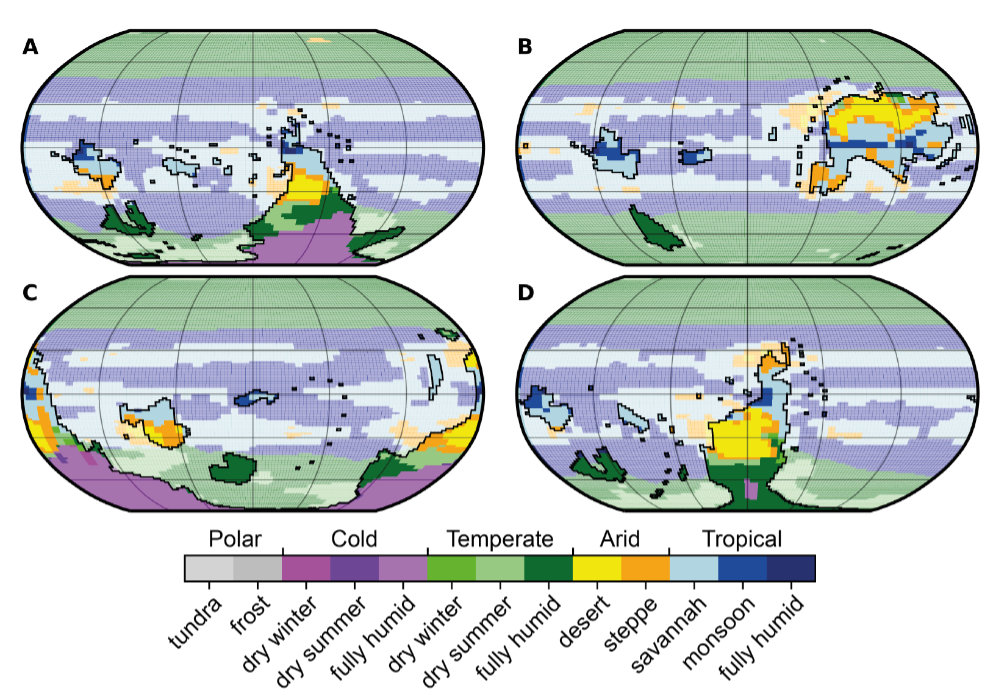Seminary tuesday 19 march 2024
 Earth System dynamics at the dawn of the animal-rich biosphere
Earth System dynamics at the dawn of the animal-rich biosphere
Thomas W. Wong Hearing, University of Leicester, UK
(& Thomas H. P. Harvey, Alexandre Pohl, Alex G. Liu, Mark Williams)
Tuesday 19 march 2024
Abstract
Animal life first flourished in Earth’s seas during the Neoprotoerozoic–Phanerozoic transition (approximately 580 to 520 million years ago), as revealed by the fossil record of the enigmatic Ediacaran biota and the ‘weird wonders’ of the Cambrian explosion. This 60 million year interval was a time of profound macroevolutionary innovation, seeing not just the rise of animal life, but the evolution of new ways of living, like crawling, burrowing, and building hard skeletons from biominerals. The late Ediacaran and early Cambrian interval was also a time of irreversible climatic transition, from the wild freeze-fry swings of the ‘Snowball Earth’ Cryogenian Period to the more muted, but higher frequency, climate oscillations of the Phanerozoic.
Perhaps surprisingly, the environmental context and Earth System boundary conditions through this macroevolutionary revolution remain rather poorly constrained. These boundary conditions include, for instance, the positions of the continents and the composition of the atmosphere, which exert fundamental controls on climate. There is, therefore, only a loose framework for interpreting correlation, cause, and effect in the interplay between the physical Earth System and the biosphere during the early evolution of animals. In this talk, I will summarise the current state of our understanding of Earth System boundary conditions like geography, atmospheric composition, and climate through the Neoproterozoic–Phanerozoic transition, and discuss some of the ways in which we are working to reduce the uncertainty envelopes around these conditions, including with iterative comparison of geological data and palaeoclimate model simulations.
- extrait:
- lien_externe:
- kc_data:
- a:8:{i:0;s:0:"";s:4:"mode";s:0:"";s:3:"css";s:0:"";s:9:"max_width";s:0:"";s:7:"classes";s:0:"";s:9:"thumbnail";s:0:"";s:9:"collapsed";s:0:"";s:9:"optimized";s:0:"";}
- kc_raw_content:
 Earth System dynamics at the dawn of the animal-rich biosphere
Earth System dynamics at the dawn of the animal-rich biosphereThomas W. Wong Hearing, University of Leicester, UK
(& Thomas H. P. Harvey, Alexandre Pohl, Alex G. Liu, Mark Williams)Tuesday 19 march 2024
Abstract
Animal life first flourished in Earth's seas during the Neoprotoerozoic–Phanerozoic transition (approximately 580 to 520 million years ago), as revealed by the fossil record of the enigmatic Ediacaran biota and the 'weird wonders' of the Cambrian explosion. This 60 million year interval was a time of profound macroevolutionary innovation, seeing not just the rise of animal life, but the evolution of new ways of living, like crawling, burrowing, and building hard skeletons from biominerals. The late Ediacaran and early Cambrian interval was also a time of irreversible climatic transition, from the wild freeze-fry swings of the 'Snowball Earth' Cryogenian Period to the more muted, but higher frequency, climate oscillations of the Phanerozoic.
Perhaps surprisingly, the environmental context and Earth System boundary conditions through this macroevolutionary revolution remain rather poorly constrained. These boundary conditions include, for instance, the positions of the continents and the composition of the atmosphere, which exert fundamental controls on climate. There is, therefore, only a loose framework for interpreting correlation, cause, and effect in the interplay between the physical Earth System and the biosphere during the early evolution of animals. In this talk, I will summarise the current state of our understanding of Earth System boundary conditions like geography, atmospheric composition, and climate through the Neoproterozoic–Phanerozoic transition, and discuss some of the ways in which we are working to reduce the uncertainty envelopes around these conditions, including with iterative comparison of geological data and palaeoclimate model simulations.
